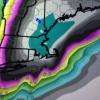-
Posts
74,610 -
Joined
-
Last visited
Content Type
Profiles
Blogs
Forums
American Weather
Media Demo
Store
Gallery
Everything posted by 40/70 Benchmark
-
We already knew not all of these were going to work out, random deterministic orgie runs not withstanding....
-
Final Call for Weekend Snows No Major Changes to Forecast Synoptic Overview: There are no significant changes to the synoptic forecast overview from First Call on Thursday. The next in a succession of northern stream impulses is approaching the area this weekend. The primary difference with this system relative to many of the disturbances that we have dealt with this season is that it is actually intensifying slightly on approach, as opposed to shearing out. This is due at least in part to the Alaskan ridge growing in amplitude, which in turn lowers heights downstream and allows the wave to "dig" a bit on approach. Expected Storm Evolution: Snowfall will overspread this area quickly this evening from west-southwest to east-northeast, rapidly becoming heavy over southwestern New England, where very heavy bands become established later this evening. This will represent one potential area of somewhat higher snowfall totals across the region. Some mixing with rain over the outer cape and islands will cut down on accumulations in those locales. The other area of subtle enhancement will be to the north, as the banding to the south weakens a bit as it translates eastward, and the best lift focuses north Sunday morning. This will become evident in radar imagery as the morning progresses and echoes over especially the south half of the area rapidly weaken. However, snowfall will be more tenacious to the north of the developing m id level low, throughout the route two region, which will prolong the storm and allow this area to catch up a bit with the southern zone of enhancement. Drier air will end the snowfall more quickly to the south, as any rain rapidly transitions back to snowfall before ending on the cape and islands early Sunday afternoon. Final Call: First Call Issued Thursday February 6th.
-
But I thought we knew stein would last all winter when fall was dry?
-
Verification for Messy Thursday Fairly Strong Forecast Here is the reality versus the forecast for the messy Thursday, weak storm system that impacted the region yesterday. The mid level warmth was slightly more aggressive than implied in the forecast, so the 1-3" area would have been better represented by a coating to 2" range, and the 2-4" maximum area to the north should have been 1-3". The slight glaze did indeed materialize towards the end of the event across a large majority of the area, as expected. Final Grade: A-
-

Tracking February 6. Light to moderate event potential
40/70 Benchmark replied to Typhoon Tip's topic in New England
A- https://easternmassweather.blogspot.com/2025/02/verification-for-messy-thursday.html -
Wife is happy to miss it...kids are a bit too young to be really bent out of shape
-
Don't forget the draft material, too..
-
What an orgy of a stretch to have no wife or kids...just unadulterated, meteorological fellatio for over a month
-
Yup.
-
Well..is there a front load that I missed?
-
Every single one of them ends with an erotic moment between the 4 walls, the KU book and me
-
You wonder how much more of this it will take for the masses to accept that things are changing....I mean, hellllooooo......there is a reason the gradient is so fast every waking moment...
-
Yea, this will rot well into March....toss guidance. Family departs for Dubai tomorrow, and I don't join them until mid May, so I'm just going to camp out on the living room floor in my crotchless skipants with a 12 pack of Odouls
-
First Call for Weekend Snowfall Several Inches Likely OverNight Saturday Into Sunday Synoptic Overview: The next in a succession of northern stream impulses will approach the area this weekend. The primary difference with this system relative to many of the disturbances that we have dealt with this season is that looks to be intensifying on approach, as opposed to shearing out. This is due at least in part to the Alaskan ridge growing in amplitude, which in turn lowers heights downstream and allows the wave to "dig" a bit on approach. Expected Storm Evolution: Snow looks to break out early in the evening on Saturday from southwest to northeast, and the precipitation shield will have overspread the entire region prior to midnight. Snowfall will mix with sleet and rain along the south coast and especially the cape and islands during the predawn hours on Sunday, with a complete change to to rain likely over the outer cape and Nantucket island. The heaviest amounts should occur in bands that will set up to north of the track of the developing mid level low during this time, along and north of the Mass pike. Precipitation should begin to taper off Sunday AM, and wind down as snowfall everywhere by midday Sunday. FIRST CALL: Final Call will be issued on Saturday.






